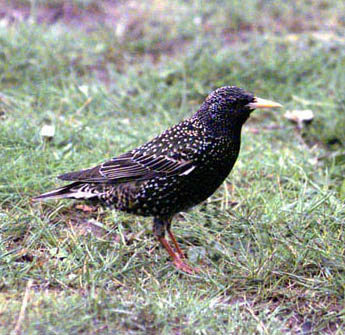Pests
Sturnus vulgaris L. - European Starling
Systematic position.
Class Aves, order Passeriformes, family Sturnidae, genus Sturnus. There are 10-11 subspecies within the former USSR.Biological group.
Harmful birds.Morphology and biology.
The body is massive, the neck short, and the legs are long with big bent claws. The beak is sharp, thin and long, slightly bent downward. The tail is short and nearly straight. Adult males have black plumage with glossy metallic shimmer of different hue; i.e., purple, violet, blue, green, or copper; the tips of the feathers have white-colored flecks which disappear in spring. The wings and tail are fulvous; the legs are reddish brown. The beak is yellow in spring and summer, then it becomes black. Adult female is similar to male, but its coloration is dimmer. Young birds are dark-fulvous, and by autumn they begin to resemble the adults, but with more variegated coloration. Adult starling body length is about 230 mm, wing length is 118-135 mm, weight is 65-85 g. The favorite habitats of this bird are open spaces, such as fields, pastures, steppe plots next to woody vegetation. The European Starling is everywhere prone to cultural landscape and to watersides. This is a usual migratory bird; it flies from north regions of the area to warm countries for winter, and the populations nesting in the south have a settled lifestyle.Distribution.
Within the former USSR, the species occurs from the western state boundaries eastward to Baikal Lake; in the north, the area reaches the limit of the arable lands; in the south, it occupies Crimea, the Caucasus, Central Asia, and Altai Mountains. The European Starling spends winter in Western and South Europe, in the northern part of Africa, in the south of Central Asia, and in Asia Minor. At present, this species is introduced and widely distributed in North America, South Africa, Australia, New Zealand, and on many islands in Oceania.Ecology.
This is the most massive bird species in the major part of its area. The European Starling nests by both separate couples and large colonies. It makes nests in rather different places; i.e., under the roof of houses, in starling houses, trunk hollows, in ground burrows at cliff edges in steppe zone. Every batch contains 5-6 eggs of blue or bluish-green color without spots. In the southern part of the area, there are usually two egg-layings per summer. Male and female in turn incubate the eggs for 13-15 days. Both parents feed the nestlings, bringing food to the nest up to 300 times a day. On 15th-17th day, the fledglings leave the nest and start flitting from one tree to another. The male nourishes them and teaches them to seek food by themselves. At the same time, the female starts laying eggs again. When young birds of the second batch leave the nest, the birds form large flocks (of hundreds and thousands individuals) and begin to migrate in search of food. They feed on the ground more often. Their diet is extremely diverse, but insects, larvae, earthworms and other invertebrates prevail. With the lack of animal food, the European Starling easily changes its diet for plant foods.Economic significance.
This is a synanthropic bird species, which is closely connected with the economical activity of humans. Positive and negative roles of starlings change by seasons and agro-climatic zones, and depend on the set of arable crops. The most significant harm is recorded in orchards, berry plantations and vineyards. Thus, in the Northwest region of the Russian Federation (Leningrad and Kaliningrad Regions), growing of cherry becomes unprofitable because of the constant yield destruction. Here the area of the orchards is limited, and the number of birds concentrated there during fruit ripening is usually high. In the south of the European part of Russia and in Kazakhstan, large flocks of the starling flying to their winter places and stop for feeding in vineyards. In this case, the yield losses amount to 20% and more. The efficient method to protect orchards and vineyards is the acoustic method of bird scaring, which is also widely implemented for this purpose in other countries.Reference citations.
Gladkov, N.A., Dementyev, G.P., Mikheev, A.V. & Inozemtsev, A.A. 1970. The life of animals. V. 5. (Birds). Moscow: Prosveshcheniye. 611 p. (in Russian).Gladkov, N.A., Dementyev, G.P., Ptushenko, E.S. & Sudilovskaya, A.M. 1964. Keys to the birds of the USSR. Yaroslavl: Vysshaya Shkola. 536 p. (in Russian).
Golovanova, E.N. 1975. Birds and agriculture. Leningrad: Lenizdat. 168 p. (in Russian).
Golovanova, E.N. 1980. Methodical recommendations on use of insect-eating birds in agricultural land, preventing of harm and protection of endangered species. Leningrad: VASKHNIL, VIZR. 46 p. (in Russian).
Ivanov, A.I. 1976. Catalogue of the birds of the USSR. Leningrad: Nauka. 275 p. (in Russian).
Ivanov, A.I. & Shtegman, B.K. 1964. Short key to the birds of the USSR. Moscow-Leningrad: Nauka. 528 p. (in Russian).
Portenko, L.A. 1954. Birds of the USSR. Part 3. Moscow-Leningrad: AN SSSR. 255 p. (in Russian).
Sema A.M. 1975. The biology of the Europen Starling in the southeast of Kazakhstan and the reduction of its harmfulness in vineyards. PhD Abstr. Alma-Ata: Kazakh State Univ. 25 p. (in Russian).


